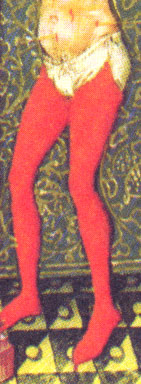Body Block:
The largest of these parts is called the body block. The body block is a large rectangle used to cover the front and back side of the trunk. It can be constructed by either using one long rectangle that is folded over at the shoulders or two smaller rectangles that are sewn together at the top of the shoulders. A neck hole is cut out of the body block, however there is some variation in the shape and finishing techniques used to finish the collar. The width of the body block is calculated by measuring the circumference around the chest/bust. This should measure the largest portion of the chest which is typically under the armpit and across the nipples. I typically add about 4" of ease to this measurement in order to give me some room to breathe/take off the tunic and also add 2" of seam alloance (1" for each front and back) then divide it in half to give me the width for the body block. For example, my chest measurement is 46". I add 4" of ease and 2" of seam allowance for a total of 52". I then divide this in half to give me the appropriate width for my body block, 26". The length of the body block depends on the type of garment you are trying to make. To calculate this, take the measurement from the top of the shoulder (shoulder seam) down to where you would like the garment to end. If you are making a knee-length tunic, this should be just below the knee, for a mid calf tunic, measure to the mid-calf, for an ankle length tunic, measure to the ankle, and so on. You will also want to add 1" for seam allowance. In my case, I found that the correct measurement from the top of my shoulder to mid-calf was about 44", so I added 1" to give me 45". If I were trying to create a patter with a one-piece body block that folded at the shoulders, I would double this number and cut out a body block that is 90" long x 26" wide. If I instead wanted to make the body block in two pieces, then I would want to cut out two 45" long x 26" wide body pieces.
Sleeves:
When it comes to creating our garments, sleeves are probably the most difficult part to pattern. At the most basic level, they are tubes that our arms go in, so we could pattern them as a rectangle, however this will result in a lot of extra material at the wrist, so I instead suggest that you pattern them as a trapezoid. In order to do this, we will need 3 measurements.
In order to calculate the length, we will need to measure the distance from the shoulder seam to the wrist, however we need to keep 2 things in mind. First, we need to make this measurement along the outside of the arm with the elbow bent so that we are measuring the longest distance that the sleeve will need to cover. Second, we need to recall that our shoulder seam will occur an inch or two further down our arm than it does on modern clothing because the body block will be wider than our shoulders. If you are confused by this second point, however, it is perfectly fine to use a measurement that is slightly too long, as you can just trim off excess sleeve length when you finish the cuff. We will also want to add 1" of seam allowance as before, so for instance, while my sleeve length measurement is 22", I cut out a 23" long sleeve.
In order to calculate the width, we need to measure the largest circumference around our arm. Once again, this occurs when the elbow is bent and the bicep is flexed. We will need to measure the circumference around the elbow. I typically add 1" of ease to this measurement and 1" of seam allowance in order to calculate how wide our trapezoid needs to be at the middle of its length. In order to finish our trapezoid, we need to take one more measurement that will tell us how narrow the sleeve needs to be at the wrist. This measurement is taken around the hand because, as you will note, your hand is larger than your wrist and needs to pass through the cuff of your sleeve. You will want to add 0.5" of ease and 1" of seam allowance to this measurement. My elbow circumference measurement was 16" to which I added 2", giving a total width of 18". My hand measurement was 10.5", to which I added 1.5", giving a total width of 12". You will note that the 18" measurement needs to be the width near the middle of the trapezoid, so the width at the shoulder will need to be wider. In order to calculate the width at the shoulder, we can simply calculate the difference between our elbow and wrist measurements (18" - 12" = 6"), divide that in half (6"/2 = 3"), and add that to the elbow measurement (18" + 3" = 21). So, my sleeve needs to be a trapezoid that is 23" long and that is 21" wide at the top and 12" wide at the bottom.
Gussets:
Gussets are small squares that help to add a bit of extra space to the base of the sleeve in order to allow for movement. While it may be tempting to simply include them into the sleeve, it also wastes fabric. Gussets should be about 6" square.
Gores:
Gores are triangles that are added to the sides and/or inserted into the middle of the body block in order to flare the bottom of the garment out and to add fullness in a fabric-efficient manner. While there are examples of dresses with as many as 12 gores, a fairly typical arrangement involves 4 gores, with one gore attached to either side of the body block, and one gore inserted into the middle of the front and back parts of the body block. The insertion of these "center gores" is done by cutting a slit into the body block. You can see an example of this in the picture of the Bocksten tunic above.
Patterning gores is relatively straightforward. The overall shape for a gore is an isosceles triangle, however cutting out this shape is relatively wasteful of fabric. I prefer to cut each gore out as a pair of right triangles by making a rectangle with the appropriate length and height, and then cutting it along the diagonal. These right triangles can be sewn together along their long edge (not their hypotenuse) in order to form an isosceles triangle-shaped gore.
The length of each gore will depend on where the flare is intended to start and where the garment will end. If I wanted a gore to go from my natural waist and the garment was supposed to reach mid-calf, then I would measure the distance from my natural waist to mid-calf. I would then add 1" of seam allowance to this dimension. The width of each gore part depends on exactly how much fullness I want to add to the garment and to some extent, how much fabric I have left. If making the gores slightly smaller means that I can use 2.5 yards of fabric instead of 3 yards, then I should make them narrower. In my repoduction of the Bocksten tunic, I ended up having a measurement of 32 inches from waist to mid-calf, so I ended up with 33" long gores. I ultimately chose to make each gore about 18" wide, so I divided that in half and added 1" of seam allowance, meaning that for each gore, I cut out a 33" x 10" rectangle and then cut that in half along the diagonal.
Layout:
Now that we have calculated the sizes for each of our pieces, it's time to consider how to lay out those pieces on our fabric. Typically linen and wool come in 60" wide pieces. Fabric should be pre-washed in the same way that you intend to wash the garment. I tend to wash the fabric with hot water, then machine dry. This tends to shrink the fabric somewhat, and I have found that 60" wide fabric shrinks down to about 56" after pre-washing. As a result, it is important to plan for this. The ultimate goal of planning our fabric layout is to determine how much fabric we need to purchase. We therefore want to be efficient with our layout so that we don't buy more fabric than we need. An example layout for a tunic based on my measurements is below. You will note that the length of the body block tends to determine how much fabric I need to purchase, and at 90", this suggests that I need to 2.5 yards of fabric in order to make my tunic.






